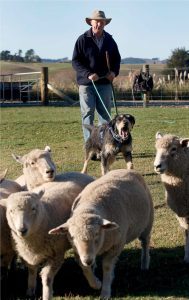 Lloyd Smith starts to teach his huntaway the art of controlling the stock with balance commands.
Lloyd Smith starts to teach his huntaway the art of controlling the stock with balance commands.
Last column I covered teaching huntaways the walk, stop and face-up commands. I also mentioned that compliance to these ensures control of your dog so consequently I do not move on until the dog is both competent and confident.
The next step is to teach some balance commands (or small sides). These allow me to monitor and control drifts in either direction by the stock being handled. The difference between these commands and full sides is that with the balance commands the dog only goes to the point of balance to correct the drift whereas full sides can mean the dog moves anywhere 180 degrees around the stock.
I teach these commands on my training sheep by drawing the dog across in either direction by using a harness and rope to ensure a controlled, clean move until the dog reaches the point of balance whereby it can then proceed to approach the sheep.
I find the advantage of teaching these commands on sheep is it helps the dog focus on their stock as you are placing the emphasis on them to read the move but it must be a clean one.
These commands can be quite precise as sometimes they are a move that only takes the dog a few metres in either direction which guarantees accuracy around the stock. Another command I introduce at this stage of training is a “Drop-Off”.
This is a great command to have at your disposal, allowing you to cope with potential problems when handling stock. It ensures you have the control to drop your dog back toward you taking pressure off stock in the process.
You can then reposition it or allow stock to pick up and move off, whatever is appropriate. I introduce a drop-off before I teach side commands because I believe it helps with the sides and assists the dog to understand that repositioning moves need to be clean giving the stock space in the process.
Often, I find I use a drop-off before giving a dog a side command to ensure that the move is a clean one.
To introduce the drop-off I put the sheep against a straight section of fence and position the dog on either side using the balance commands taught previously.
The drop-off command I use is “That’ll Do”. I start using this command from a young age on my dogs whenever I want them to come back toward me while working stock. I use “Wayleggo” to call them right off stock but “That’ll Do” means to keep working but come back toward me, so now I turn that into a drop-off.
To do this I position myself close to the sheep (once again quiet sheep are important) and do not allow the dog to pass between myself and the sheep making sure they change direction by passing behind me on the instruction of “That’ll Do” used in conjunction with the balance commands to send sideways to the point of balance.
Once they understand the implications of this I then start to move backwards, each session making the dog travel further each time to emphasise the need to Drop-off and pass behind me. You can make the dog drop as far as you like but the objective is to make the dog understand the need to keep dropping back toward you on this command. This achieved you can then stop the dog accordingly and position as required.
These commands are the first of your re-positioning moves which need to be carried out in a good clean manner whereby the dog gets itself into the right position without putting pressure on stock in the process. This is about stockmanship. It is difficult to apply good stock handling skills without having your dogs trained to a level that allows you to apply these principles.
To get the best result when moving and mustering stock you need to be able to position your dog in the right place to get the stock to move in the required direction.
If you do not have your dogs trained to a level that ensures this then you are constantly having to compromise and settle for something less than ideal.
KEY POINTS
- Balance Commands – Small accurate moves around stock.
- Drop-off Command – Great command to have at your disposal especially handling light stock or in-lamb ewes.
- Re-positioning Moves – Need to be carried out cleanly without pressuring stock in process.
- Stockmanship – Well-trained dogs allow you to execute good stock handling skills.




